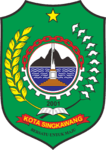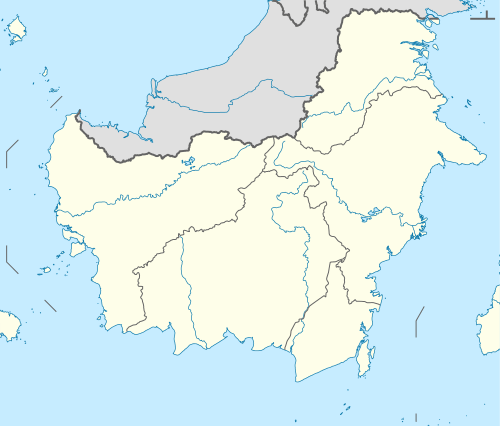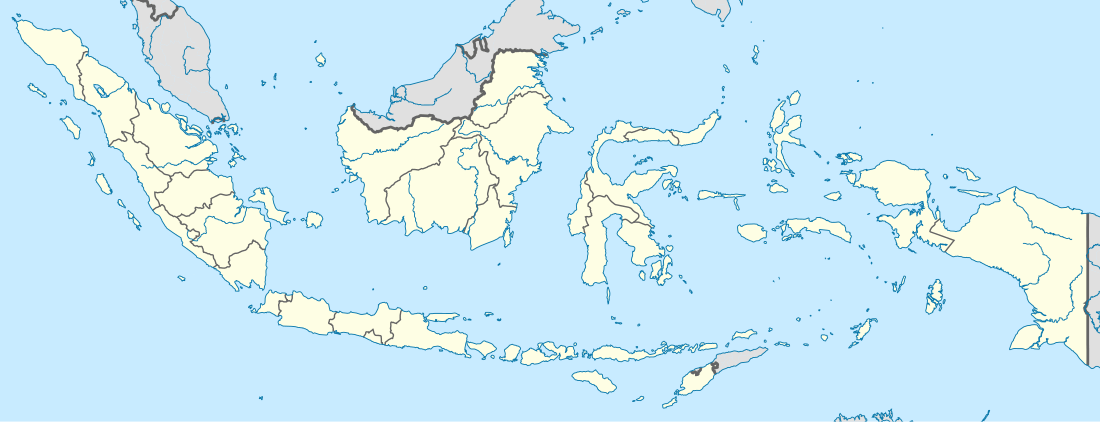Singkawang
Singkawang or San Khew Jong in Hakka (Hakka POJ: Sân-khiéu-yòng), is a city located in the province of West Kalimantan, on the island of Borneo in Indonesia. It is located at about 145 km north of Pontianak, the provincial capital, and is surrounded by the Pasi, Poteng, and Sakok mountains. Singkawang is derived from the Hakka Chinese, sân-khiéu-yòng which refers to "a town in hills nearby a sea and estuary."
Singkawang | |
|---|---|
| Other transcription(s) | |
| • Jawi | سيڠ كوانڠ |
| • Chinese | 山口洋 |
 Seal | |
| Nickname(s): Hong Kong van Borneo, Hakka Town | |
| Motto(s): Bersatu Untuk Maju, Singkawang Berkualitas | |
 Location within West Kalimantan | |
 Singkawang Location in Kalimantan and Indonesia  Singkawang Singkawang (Indonesia) | |
| Coordinates: 0°54′N 108°59′E | |
| Country | |
| Province | |
| Established | 12 December 1981 (as administrative city) 21 June 2001 |
| Districts | 5
|
| Government | |
| • Mayor | Tjhai Chui-Mie |
| • Vice Mayor | Irwan |
| Area | |
| • Total | 504.0 km2 (194.6 sq mi) |
| Population (2014) | |
| • Total | 192,844 |
| • Density | 380/km2 (990/sq mi) |
| • Demonym | Singkawangite, 山口洋人 (Shan Khew Jong-nyin) |
| Time zone | UTC+7 (Indonesia Western Time) |
| Area code | (+62) 562 |
| Website | singkawangkota |
| Singkawang | |||||||||||||||||||
|---|---|---|---|---|---|---|---|---|---|---|---|---|---|---|---|---|---|---|---|
| Chinese | 山口洋 | ||||||||||||||||||
| |||||||||||||||||||
History
Originally Singkawang is a village that part of the Sultanate of Sambas, named as Singkawang Village (Kampong Singkawang) as a haven traders and gold miners from Monterado. The miners and traders who came mostly from China, before they headed Monterado first rest in Singkawang, while gold miners in Monterado long often rest in Singkawang to remove its tiredness and Singkawang as well as the transit transportation of gold mine (gold dust ). At that time, they (the Chinese) called Singkawang as San Keuw Jong (Hakka), they assume in terms of geography that Singkawang directly adjacent to the Natuna Sea and there are mountains and rivers, where the water flows from the mountains through the river to the mouth of the sea, Seeing the development of Singkawang assessed by those who are promising enough that the miners switched professions as are farmers and traders in Singkawang and eventually the miners lived and in Singkawang till now.
From the middle of the 18th century the Chinese governed trading in the city. During the Dutch East Indies era Singkawang was a Roman Catholic main station and permanent residence of Roman Catholic clergy. The mission there was called the 'Apostolic Vicariate of Dutch Borneo' and founded among others schools, a hospital and a leprosy colony.
Administrative districts
The city is divided into five administrative districts (kecamatan), listed below with their populations at the 2010 Census:[1]
- South Singkawang 41,432
- East Singkawang 19,263
- North Singkawang 21,977
- West Singkawang 46,890
- Central Singkawang 56,900
Demographics
According to the data from the 2014 Census, the population of Singkawang was 192,844, most of which are Chinese descents (around 70% of whole population). The largest group of Chinese descent is Hakka people (locally called as "Hakka-nyin" who speak Guangdong-Hakka dialect). The other major group of Chinese descent is Chaozhou People which is better known as Teochew. The rest are Malay, Dayak, Javanese, and other ethnicities. The latest official estimate (as at January 2014) is 192,844.
The distribution of the religion practically follows the distribution of the ethnic groups; the largest groups are Buddhism followed by Confucianism, Islam, Protestantism and Catholicism.
City of a Thousand Temples
Singkawang is also known as the City of a Thousand Temples since there are many temples can be found in the city and its surrounding. Nearly every god and goddess in Chinese Mythology are worshipped here. People also worship popular historical figures like Tua Pek Kong (Hakka: Thai Phak Kung; Indonesian: Dewa Bumi), General Guan Gong, Admiral Zheng He, and Emperor Sung Tai-zu, who was found to be worshipped in the temple outside the north side of the city.
Food
Chinese food especially Hakka style dominates the food stalls or small restaurants, but Teochew style is also available. Minang style food can also be found here. Unique food like Rujak Ju Hie (鱿鱼炒; rojak with dried squid) is one of delicacies in Singkawang. Tofu (bean curd) Singkawang is famous in West Kalimantan, also Kembang Tahu (腐皮; silky smooth tofu with sugar gravy) is very popular in this city. Singkawang is also famous for its cakes. The variety of cakes is surprising and available from early morning till midnight. Choi Pan (菜粿:Steamed vegetable dumplings) also known as Chai Kue or Chai Kueh, is one of the many special traditional Asian delicacies. Believed to be of Teochew origin, it consists mainly of fragrantly stir-fried yam bean wrapped in a slightly chewy translucent skin and is steamed to perfection.[3] There are also have several Malay food such as Bubur Paddas (Malay's spicy porridge), Pedak (fermented shrimp paste) and Nasi Lemak. Kopi tiam (咖啡店; local coffee shop) with strong bitter robusta coffee can be found every where. Peaceful and safe feeling for everyone makes Singkawang to be one of the cities with lively night. One may enjoy various food in Pasar Hongkong from porridge, kwetiau, fried rice, nasi lemak, rujak (fruit & vegetables salad), cakes coffee stall. And the prices of the food are surprisingly cheap. Local people enjoy the night with their friends discussing the local hottest issues, singing, or playing cards.
Chinatown
Beside it is well known as the City of Thousands Temples, as there are many small and large temple from any corner of Singkawang region, Singkawang is also known as one of the Indonesian Chinatowns since the majority of the population is of Chinese descent, consisting of mostly Hakka and some other sub-group of Han Chinese, they're resided at any areas in the city. They still practice their culture in any ceremony or official events, from weddings to funeral ceremonies. The culture is seen as the closest to the original tradition of Chinese people (mostly refers to Fujian), making Singkawang known as the Indonesian Chinatown.
Languages
Singkawang people use Indonesian as the primary language not only in conversation or trading, but they also use their own mother tongue. As Singkawang consists of three major ethnic groups, Chinese, Malays and Dayak, Hakka people, almost all of the Singkawang people use either Indonesian or Hakka Chinese for conversation; even some members of other ethnic groups use it, too. The Indonesian used in Singkawang commonly for daily conversation is not standard Indonesian, but has some Malay influence on vocabulary as Malay is the closest language to Indonesian and the Singkawang people have for years been accustomed to Malay.
Transportation
At present there is no airport at Singkawang, and served by Supadio International Airport. It is connected by road, can be reached by bus or taxi from Pontianak covering a distance of 150 kilometers. It is also connected by road to Kuching in Malaysia via the Aruk/Biawak border and Sambas.
Proposal to build an airport, and toll road from Pontianak is now under consideration. The construction of the airport is planned to begin in 2020 and the first phase of construction is targeted to be completed in 2022.[4][5]
Festivals
- Cap Go Meh (正月半 Jang Ngiet Ban in Hakka) is celebrated on the 15th and last day of Chinese New Year, the main spotlight of the day is Tatung (大同) festival, a mixed Chinese and Dayak people rituals;
- Qingming Festival or locally known as Cheng Beng, celebrated on 4–5 April in a given year;
- May: Gawai Dayak Naik Dango is celebrated by the Dayak in the opening of the rice harvest to thank the Gods;
- June 1: Ngabayotn is celebrated by the Dayak people to celebrate the closing form of rice harvest and beginning of the cultivation season;
- August: Wayang Gantung;
- August 17: The Celebration of Indonesian Independence day;
- October: Singkawang 10 km running contest is held on Singkawang's anniversary;
- October: Dragon Cup soccer championship gathers the clubs from the surrounding districts to celebrate Singkawang's anniversary;
- October: Pawai Takbir;
- Festival Bedug on Idul Adha day;
- Karnaval Muharram celebrates Islamic new year
Around Singkawang

Places of interest around the city are:
- Villa Bukit Mas, a resort;
- Bukit Bougenville, a botanical garden about 6 km south of Singkawang;
- Chidayu Indah, is a similar garden to that of Bougenville, and lies right next to it;
- Pasir Panjang (长沙海滩) beach resort about 17 km south of Singkawang;
- Sungai Hangmoy (坑門), a river used for bathing mainly by the Hakka population;
- Kawasan Wisata, a white sanded beach 8 km south of Singkawang;
- Teratai Indah, an artificial lake used for recreation by the locals; lies only 2 km south of Singkawang;
- Vihara Chikung (济公庙), the largest Taoist temple in the area, funded by Singaporeans, located 3 km south of the city;
- Gunung Roban, a mount with a tiled path up the mountain used by the locals for easy hiking; located 4 km to the east.
- Batu Belimbing, or Starfruit Rock, a rock that resembles a starfruit. lies 8 km east of the city;
- Gunung Poteng is one of the main water resources for the city, and lies 7 km east. The mountain is a Natural Reserve where unique flora such as the Rafflesia Tuan Mudae grows;
- Sinka Island Park location at south of Singkawang in Teluk Karang has access to small Simping Island, recreational park, swimming pool and mini zoo around a hill.[6]
Mail Order Bride Scandal
There have been unsubstantiated allegations of human trafficking in Singkawang, based upon the town's mail order bride illegal business.[7] Most of the men who travel to Singkawang looking for young women to marry are from Taiwan, China, or Singapore. These men arrive and get in touch with brokers, these brokers then approach families with suitably aged daughters and generally offers these parents about 6 million rupiahs (about US$450) for each girl.
It is most normal for a majority of these foreign clients to pay an amount exceedingly more than what is requested by the brokers and most payments are at an average of 30 million rupiahs (about US$2,250). Contracts are often drawn between the brokers and the clients. It is a fact that each contract includes a time period clause and most of these marriages are contractually bound for 2 to 4 years, some for even shorter periods of time. It is also common for these relationships to not be legally bound marriages.
Indonesian police actively arrest the offender of mail order bride.[8]
Sister cities
Notable people
- Morgan Oey, singer
- Christiandy Sanjaya (黃漢山), Deputy Governor of West Kalimantan
References
- Biro Pusat Statistik, Jakarta, 2011.
- Indonesia's Population: Ethnicity and Religion in a Changing Political Landscape. Institute of Southeast Asian Studies. 2003. ISBN 9812302123
- http://www.huangkitchen.com/chai-kuih/
- "Ground breaking for Singkawang airport project to take place in May". Antara News. Retrieved 8 May 2019.
- "Tol Pontianak-Singkawang Layak Dibangun". Kompas. Retrieved 8 May 2019.
- "Jika ke Singkawang, Ayo Mampir ke Sinka Island Park". February 3, 2012.
- Indonesia, Etc.: Exploring the Improbable Nation, Elizabeth Pisani, p. 286
- https://www.antaranews.com/berita/931464/polres-singkawang-gagalkan-pengiriman-warga-yang-diduga-korban-tppo
- Rendra Oxtora; Aria Cindyara; Fardah Assegaf (9 July 2019). "Sarawak Chambers explore cooperation with Singkawang". Antara. Archived from the original on 26 September 2019. Retrieved 26 September 2019.
External links
| Wikimedia Commons has media related to Singkawang. |
- (in Indonesian) Official Singkawang Website